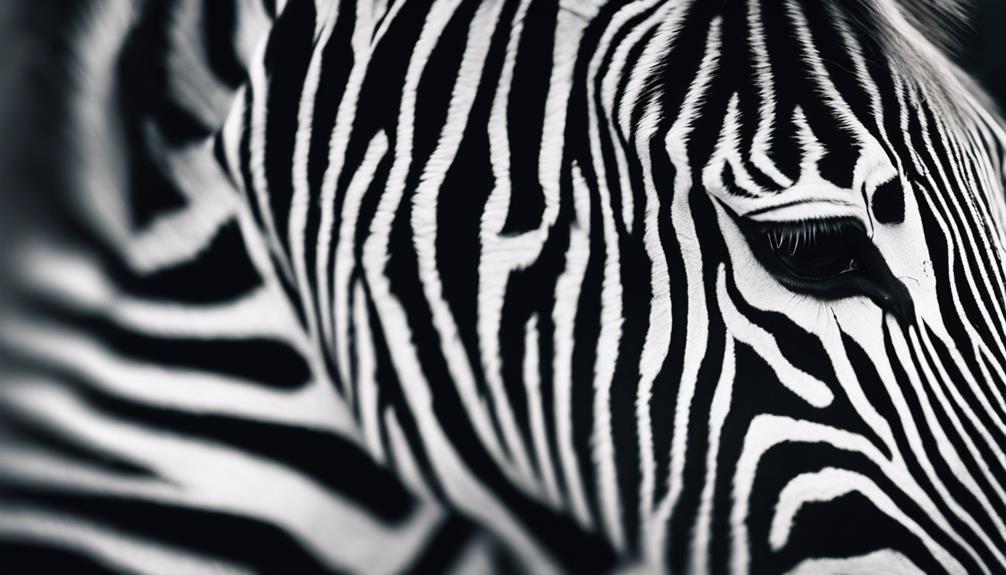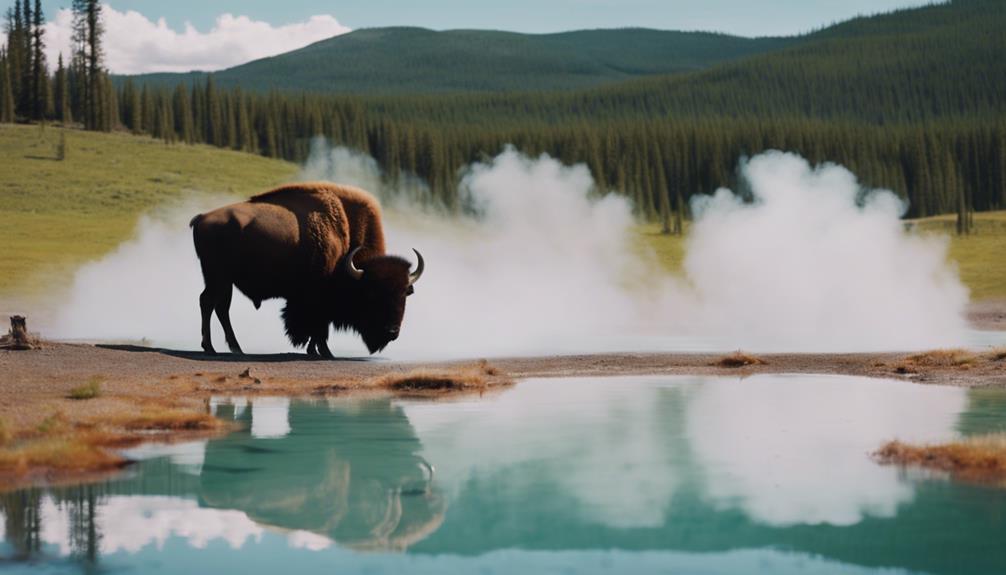Explore the enchanting world of zebras, uncovering 10 fascinating striped wonders. Learn how their black and white stripes provide defense and communication. Discover the three zebra species and their vibrant vocal language. Witness the dazzling speed of up to 65 km/h for escaping danger. Explore the beauty of their group dynamics and exceptional eyesight. Each zebra's unique black skin with white stripes aids in survival. Uncover the mystery behind their wildebeest-like migrations and the critical role zebras play in maintaining ecosystems. There's more to these striped wonders than meets the eye—fascination awaits!
Zebra Stripes: Defense Mechanism
Using their distinct stripe patterns, zebras effectively outwit predators, showcasing an intricate defense mechanism that confuses and deters potential threats. The black with white stripes of the Plains Zebra serves as an essential camouflage in the grassy plains where they roam. These stripes create an optical illusion, making it challenging for predators to single out an individual zebra from the herd. As a result, predators like lions or hyenas find it difficult to target a specific zebra, increasing the chances of survival for the group.
Moreover, the black and white stripes also help regulate the zebra's body temperature. The black stripes absorb heat from the sun, while the white stripes reflect it, creating air currents that cool the zebra down. This adaptation is vital for zebras living in hot savannas where temperatures can soar. The stripes not only protect them from predators but also aid in maintaining their physical well-being in their natural habitat.
Three Zebra Species

Three zebra species inhabit different regions of Africa, each uniquely adapted to their specific habitats and environmental conditions.
- Plains Zebras: These zebras are commonly found in eastern and southern Africa, roaming the vast grasslands and savannas. Their black and white stripes provide excellent camouflage within these open plains, helping them evade predators like lions and hyenas.
- Grevy's Zebras: Inhabiting dry semi-desert areas of Kenya and Ethiopia, Grevy's zebras have distinctive narrow stripes and large ears. These features aid in heat dissipation, essential for survival in arid environments where water sources are scarce.
- Mountain Zebras: Thriving in the mountainous regions of Namibia, Angola, and South Africa, these zebras are well-suited for rugged terrains. Their thick coats protect them from the cold temperatures at higher altitudes, while their strong hooves enable them to traverse rocky landscapes with ease.
Each zebra species has evolved specialized traits that enable them to thrive in their respective habitats, showcasing the remarkable adaptability of these striped wonders.
Stripes: Natures Barcodes
Imagine each zebra's stripes as a unique barcode, designed for identification just like the ones on your groceries. These patterns are not just for show; they play an essential role in helping zebras recognize one another and communicate effectively within their herds. The evolution of these striking stripes has equipped zebras with a sophisticated system of individual identification and social interaction.
Evolution of Zebra Stripes
The evolution of zebra stripes, akin to nature's barcodes, showcases a remarkable adaptation that serves multiple functions important to their survival.
- Zebra stripes have evolved as a defense mechanism to confuse predators and regulate body temperature.
- Each zebra's unique stripe pattern acts as a tool for individual identification and aids in conservation efforts.
- There may be a social purpose behind the evolution of zebra stripes, helping zebras recognize each other and communicate within their groups.
- The contrasting black and white stripes result from melanocyte cells in their dark skin and lack of pigmentation in their white fur.
Zebras' striped wonders play an essential role in their survival by providing camouflage, signaling danger, and enhancing social interactions within their herds.
Purpose of Striped Pattern
Striped patterns on zebras not only serve as nature's barcodes for individual identification but also play an important role in aiding conservation efforts and enhancing social interactions within their herds. These unique stripes are crucial for researchers to track and monitor zebra populations effectively. Moreover, within their herds, the striped patterns potentially help zebras recognize each other, fostering social bonds and cooperation. Each zebra's stripes are as unique as a fingerprint, making it easy to distinguish one from another. Additionally, the striped pattern aids in zebra camouflage, blending them into the grasslands, and confusing predators, ultimately increasing their chances of survival.
| Striped Pattern | Conservation |
|---|---|
| Nature's barcode | Track zebra populations |
| Social purpose | Enhance social bonds |
| Distinctive patterns | Aid in individual recognition |
| Camouflage | Confuse predators |
| Survival | Protect from threats |
Black With White Stripes
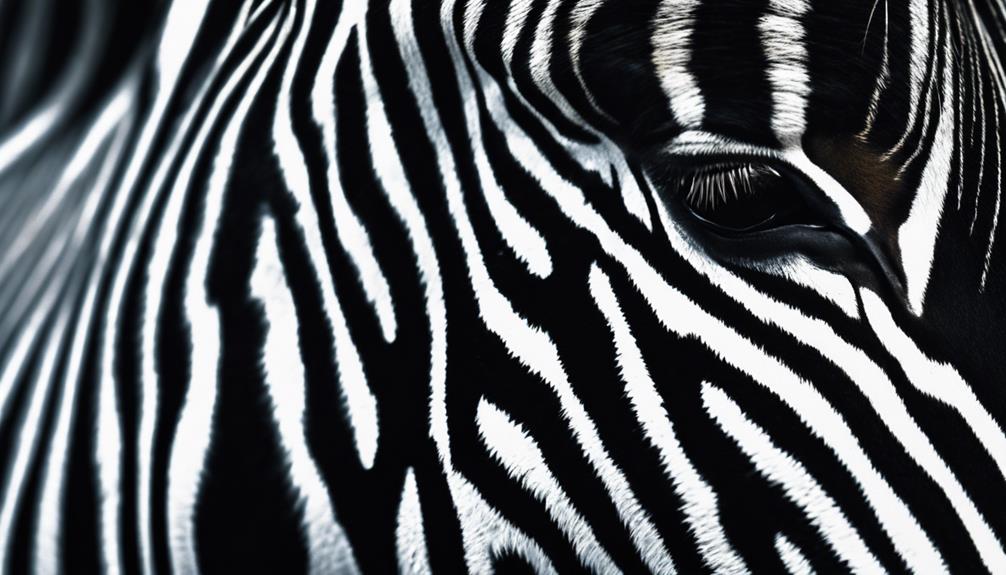
Beneath their striking black and white stripes, zebras actually have black skin as the base color, with melanocyte cells responsible for producing the distinctive patterns. Here's why this matters:
- Default Color: Zebras' black skin is the canvas on which their white stripes are painted, making black their natural color.
- Melanocyte Magic: Melanocyte cells in their dark skin work their magic to create the bold black stripes, while the white fur remains pigment-free.
- Stripe Significance: The stripe patterns act like barcodes, aiding in individual zebra identification and recognition within their herds.
- Defense Mechanism: Apart from their aesthetic appeal, the black and white stripes serve as a defense mechanism, helping zebras confuse predators and ward off bugs.
These black and white stripes are not just a fashion statement for zebras; they are an integral part of their survival strategy, providing camouflage and protection in the wild.
Vocal Communication

Did you know that zebras have their own unique way of communicating with each other? They use vocal expressions like whinnying and braying to convey important messages about danger and dominance within the herd. By understanding these distinctive vocalization patterns, you can gain insights into the social behaviors and interactions of these fascinating animals.
Zebra Vocal Expressions
Utilizing various vocalizations like whinnying and braying, zebras effectively communicate important information within their herd, including details about danger, dominance, and social interactions. Here are some fascinating insights about zebra vocal expressions:
- Whinnying and Braying: Zebras use whinnying to locate each other and express excitement, while braying is often a sign of alarm or warning.
- Danger Signals: Specific vocal cues alert the herd to potential threats, helping them stay vigilant and react swiftly.
- Dominance Calls: Zebras establish hierarchy through vocalizations, asserting dominance or submission within the group.
- Social Interactions: Vocal communication fosters bonds within the herd, facilitating cooperation and coordination for activities like migration or defense.
Social Communication Behaviors
Zebras communicate important information within their herd through a variety of vocalizations, such as whinnying and braying, which play a significant role in maintaining social cohesion and dynamics. These vocal signals are vital for conveying messages about danger, dominance, and other social cues. By relying on vocal communication, zebras establish and reinforce their social interactions within the group. Different vocalizations serve specific purposes, helping zebras navigate their complex social structure effectively. Understanding zebra vocal communication is key to unraveling their social dynamics and behaviors, providing insights into how these striped wonders interact and coexist within their herds. So next time you hear a zebra's call, remember it's more than just a sound – it's a language of social connection.
Distinctive Vocalization Patterns
Amidst the vast savannah, the symphony of distinctive vocalization patterns among these striped marvels weaves a tapestry of communication essential for their survival and social cohesion. Here are some fascinating insights into zebra vocalization patterns:
- Zebras communicate through a variety of vocalizations, such as whinnying and braying.
- Vocal communication helps convey vital information about danger and dominance within the group.
- They use vocalizations to alert others in the herd about potential threats or changes in their environment.
- Different vocalization patterns signify various messages, contributing to the social cohesion and survival of the zebra group.
Understanding these vocalization patterns is key to interpreting zebra social cues and behaviors in the wild.
Non-Picky Eaters
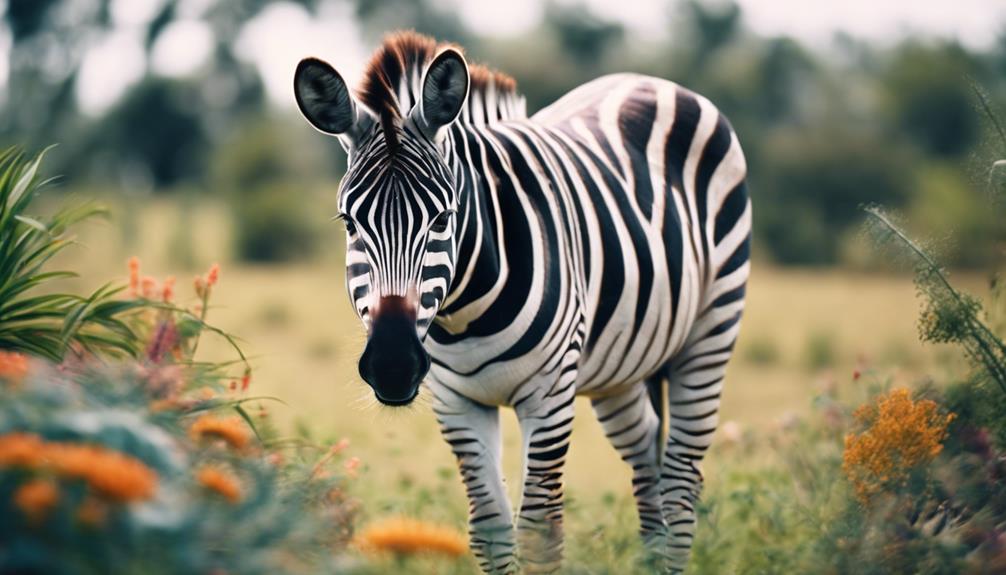
With their diverse herbivorous diet, zebras surprisingly show a lack of pickiness in their feeding habits, consuming a wide range of grasses, leaves, and shrubs to meet their nutritional needs. These striped wonders spend a significant amount of time grazing to make sure they maintain their energy levels and overall health. Zebras have a specialized digestive system that efficiently processes fibrous plant material, enabling them to thrive on their herbivorous diet. Access to fresh water sources is essential for zebras to stay hydrated, especially in their natural habitats where water may be scarce.
Let's take a closer look at the variety of vegetation that zebras enjoy munching on:
| Grasses | Leaves | Shrubs |
|---|---|---|
| Bermuda | Acacia | Juniper |
| Fountain | Willow | Boxwood |
| Ryegrass | Maple | Jasmine |
| Fescue | Oak | Rose |
| Bluegrass | Birch | Pine |
Wildebeest-Like Migration

As you explore the fascinating world of zebra behavior, one remarkable aspect that stands out is their wildebeest-like migration patterns. These striped wonders exhibit an incredible ability to move in search of sustenance and water, reminiscent of the famous wildebeest migrations. Here are some intriguing insights into their migration habits:
- Adaptability: Zebras, including the Mountain Zebra species, showcase adaptability by migrating to follow seasonal rains for grass and water sources.
- Resource Access: Migration allows zebras to access food and resources in changing environments, ensuring their survival and well-being.
- Group Travel: Similar to wildebeest, zebras move in groups during migration, leveraging safety in numbers against potential predators.
- Conservation Importance: Understanding zebra migration patterns is crucial for conservation efforts aimed at preserving their habitats and ensuring the sustainability of these magnificent creatures.
Witness these white with black stripes beauties, members of the horse family, as they set off on their awe-inspiring journeys across the savannah.
Speed for Escaping Danger
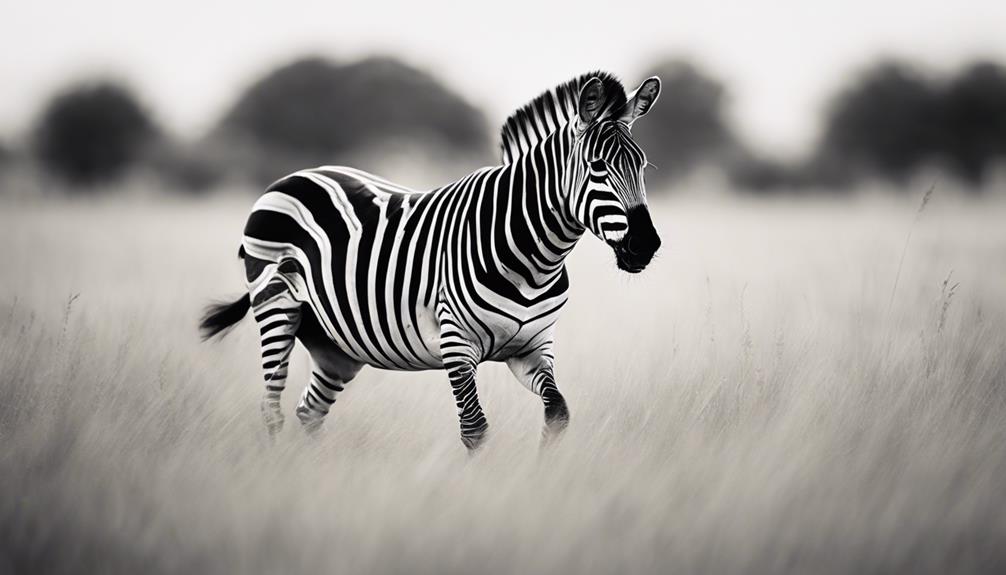
Did you know that zebras can sprint up to 35 miles per hour to evade predators? Their incredible speed and agility make them elusive targets in the wild. Zebras rely on their quick bursts of speed to outstrip danger and guarantee their survival.
Zebra Speed Abilities
Zebras harness their incredible speed abilities as an essential survival mechanism when escaping danger in the wild. Here are some fascinating facts about their speed abilities:
- Zebras can reach speeds of up to 35 miles per hour to outrun predators.
- Their agility and speed make them challenging targets for predators in their natural habitat.
- Zebras have impressive stamina, allowing them to sustain their speed over long distances.
- When threatened, zebras can use their powerful kicks as a defense mechanism.
These remarkable capabilities, coupled with their top speed of 40 mph, enable zebras to thrive and survive in the wild, evading danger and outmaneuvering predators effectively.
Escaping Predators Quickly
Utilizing their remarkable speed and agility, zebras swiftly evade predators in the wild, employing clever tactics to outsmart and outpace their pursuers. With the ability to reach speeds of up to 35 miles per hour, zebras have a significant advantage when it comes to predator evasion. Their agility allows them to maneuver quickly through various terrains, making it challenging for predators to keep up. Zebras also use a zigzag running pattern, confusing their enemies and gaining precious seconds to escape. Enhanced senses like acute hearing and sharp eyesight help zebras detect danger early, giving them a head start in their swift escape. Additionally, their distinctive stripe pattern serves as a visual illusion, making it harder for predators to single out an individual zebra in the herd.
Survival Through Swiftness
Swift evasion from predators is an essential survival strategy for zebras in the wild, relying on their exceptional speed to outmaneuver and outpace potential threats. When it comes to surviving in the savanna, zebras have mastered the art of speed and agility. Here's why their swift movements are vital:
- 35 MPH: Zebras can reach speeds of up to 35 miles per hour, a remarkable pace for outpacing predators.
- Zigzag Tactics: Their swift running ability allows them to zigzag unpredictably, making it challenging for predators to catch them.
- Defense Mechanism: Speed is a crucial defense mechanism for zebras, helping them evade threats in their natural habitat.
- Endurance: Zebras possess stamina advantages, enabling them to sustain their fast pace over long distances when fleeing danger.
In the wild, speed is not just a luxury for zebras; it's a necessity for survival.
A Dazzling Group

In the vast savannahs of Africa, a striking and cohesive group known as a 'dazzle' roams the landscape, exemplifying the social nature of these enchanting striped animals. Zebras, with their black and white stripes, form intricate social structures within their herds, showcasing fascinating herd dynamics, social interactions, and community behavior. These zebras exhibit a strong sense of unity and rely on each other for protection and survival in the wild.
| Aspect | Description | Importance |
|---|---|---|
| Herd Dynamics | Zebras live in herds led by a dominant male, coordinating movements and responses to threats as a cohesive unit. | Essential for safety and coordinated group actions. |
| Social Interactions | Zebras groom each other, maintain social bonds, and communicate through various vocalizations and body language. | Critical for establishing hierarchy and cooperation. |
| Community Behavior | Zebras exhibit altruistic behaviors, protecting weaker members and working together to defend against predators. | Essential for ensuring the survival of the entire group. |
Great Zebra Eyesight
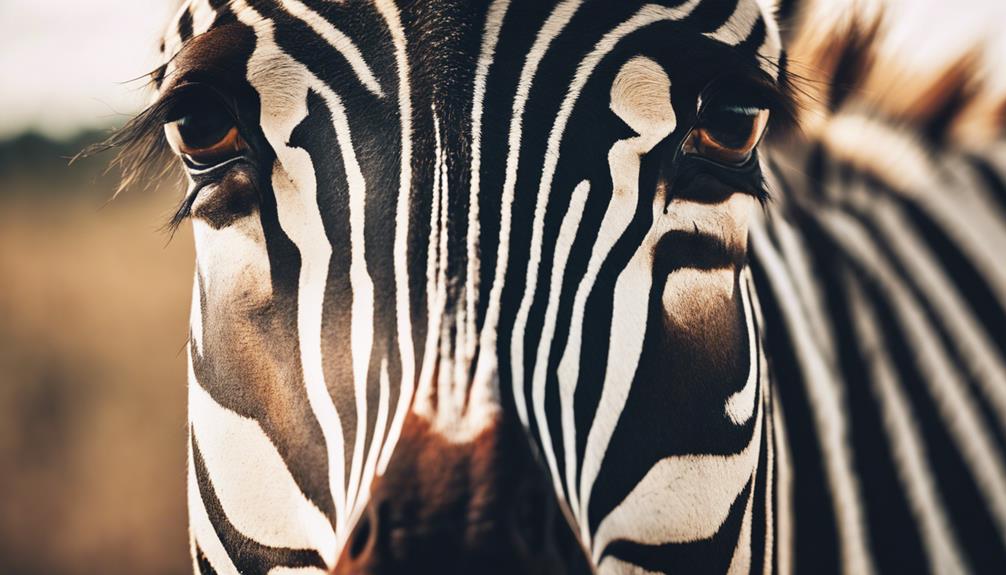
With their exceptional eyesight and keen awareness, zebras effortlessly scan their surroundings for potential dangers and opportunities, showcasing their remarkable visual acuity in the wild savannahs of Africa. Here's why their eyesight is truly exceptional:
- Night Vision Capabilities: Zebras possess the remarkable ability to see well in low-light conditions, giving them an edge during the darker hours of the day when predators may lurk.
- Color Perception Advantages: Being able to see in color aids zebras in distinguishing between different types of vegetation, allowing them to identify suitable food sources amidst the grasslands.
- Wide Field of View: With eyes positioned on the sides of their heads, zebras enjoy a panoramic view of their surroundings, enabling them to detect predators approaching from various angles.
- Enhanced Survival Skills: The combination of their keen eyesight, color perception, and wide field of view contributes significantly to the zebras' survival in the African wilderness, helping them navigate and thrive in their natural habitat.
Conclusion
Now that you've uncovered the striped wonders of zebras, you can see why these majestic creatures are nature's barcode! From their dazzling stripes to their wildebeest-like migration, zebras are truly a sight to behold. So next time you see a zebra, remember their amazing defense mechanisms, vocal communication, and incredible speed. These striped wonders are more than just black and white – they are nature's own work of art!
